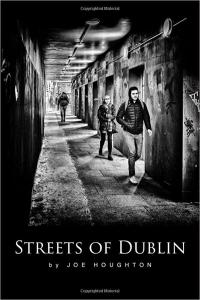
Based in Dublin Joe Houghton is a professional photographer with a day job as a professor of management at a Dublin university. He runs a photography training business and was Nikon’s trainer in Ireland for 10 years. He began his talk with the Henri Cartier Bresson image Behind the Gare St Lazaire, arguably the earliest street photograph. It would be panned by judges today but is one of the 100 best photographs of all time according to Time magazine. It illustrated that street is not a favoured genre today, yet it is just as important as other genres such as portraits, ICM and texture. For Joe street photography is what he does because he enjoys it and he does it for nobody else but him.
His journey began after a frustrating visit to Dublin by car when his wife suggested that he take the bus next time. A 20-minute journey along bus lanes passing the traffic gave him an hour to spare. He was also in a creative slump with his photography and so wandered around taking photographs. The problem was he was using a Nikon D810 and 24-70 lens which was hardly inconspicuous and not the right tool for the job. He needed a new camera. He settled on the Fuji X100s as it was tiny, light and compact and looks like a proper film camera. His “go-to” setting is 1/250th at f4 with ISO at 400. Ready for the opportunity he realised that with street photography things happen quickly and the photographer has to adjust to what is going on around him/her and decided to shoot completely manual. He then faced the fear of not believing that you could just go up to a stranger and ask if you can take a photograph. An early example, before he had learned to offer to send the subject a copy, was totally anonymous, but by posting the image on Instagram he received an email from Bulgaria and was able to share the image with the subject. He also learned quickly about “the decisive moment” that makes an image. He also learned that street photography is about shooting people on the street, its life and the interactions on the street. “Tooting” into windows, especially hairdressers is often rewarding. If he is clocked, he always acknowledges the subject and goes to speak to them. With experience he gradually learned the art and less often missed shots because he was too slow. The exposure triangle became second nature, and he developed a sense of anticipating what was going to happen to capture the decisive moment.
Although pleased with his Fuji X100s it did not have a “flippy” screen, so the movement in framing the shot became distracting. He came to another, “I need another camera" moment. The Fuji XT-2 met the bill. It also has interchangeable lenses. Using a lens adapter, he can mount any lens onto this camera. A mirrorless camera also allows for focus peaking which means that he can set the zone of focus in advance.
His workflow includes shooting in RAW but setting the camera to show a black and white image on the screen. He processes in Lightroom Classic and has a pre-set that automatically switches the input to black and white (the V key is a short cut). He regularly uses a square crop. “Subject, background, corners” is the next step for composition. Losing the sky often removes the brightest part of an image. Whereas the HSL slider adjusts colours in black and white the slider adjusts the RAW colours in different tones of grey for black and white. He likes a high contrast, grungy look and uses masking to enable him to accentuate the areas that he wants to affect in the image. He then uses Nik Silver Effects to complete the effect that he wants. Vignetting then often creates the pool of light in the main part of the image.
Joe creates a daily panel of his best shots to create an additional image. He has also written several books including one on Street Photography called Streets of Dublin. More information is available at Joe's website.
